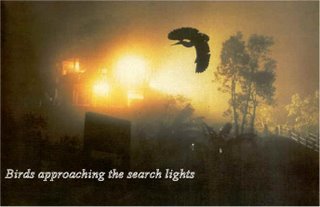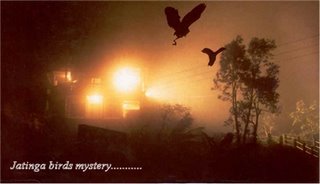Saturday, August 19, 2006
Jatinga's Bird Mystery

As fog comes on a moonless night........
when the wind blows in direction right.....
Jatinga turns into an island of search light,
& birds appear like ghosts from nowhere.
Do birds commit suicide? This was the foremost question in the minds of bird enthusiasts and of those idly curious. Birds come in hundreds to Jatinga and die. This much is commonly subscribed to.
Birds are trapped by bird lighting at Jatinga. They are attracted by artificial lights on dark moonless nights and are either killed or trapped. A similar light phenomenon occurs in the Philipines in about the same time and in similar climatic conditions i.e. on foggy,windy and moonless nights. While most of the birds are trapped with what they call "Tawang" in the Philippines are supposed to be migrants, those at Jatinga are not necessarily so.

True, the villagers of Jatinga killed the birds for their table. But they treated it as a sport. The villagers do not betray any sense of guilt. They had countered our shocked disbelief by asking point blank: "Don't you kill fish in the plains in a similar manner with the years first flood? They considered the coming of the birds to be a gift of the Gods.
Jatinga is a Jeme-Naga word meaning pathway of rain and water. In the 1890s some Jeme-Naga people came to survey the area and camped there for a couple of days. Seeing their camp fires attract birds they suspected something mysterious and thought better of permanently settling in the area. Even now, in the Lomromom hill, there is no permanent human settlement. The people of Jatinga and of neighbouring areas consider that place unhealthy and not necessarily for earthly reasons.

Birds come in large numbers from August to October on foggy moonless nights. Even in July and November birds appear, but in decidedly fewer numbers. The time of the phenomenon occuring coincides with that of migration. This valley falls on the migratory route of locally migrating birds-the Borail being the psychological as well as physiological support along which they could fly. And all the thirty seven species observed and recorded are local migrants. On moolit nights without fog, species like the Pond Heron and the Cattle Egret were seen moving further south in small flocks over coming this ridge. These species were later i.e. after the Phenomenon, observed at Harangajao, a place about 10 K.M. away aerially in the south, which is the ideal habitat for these species.